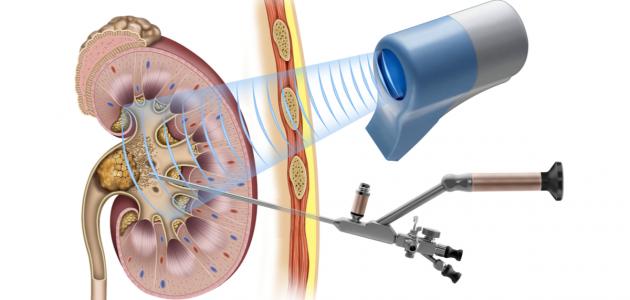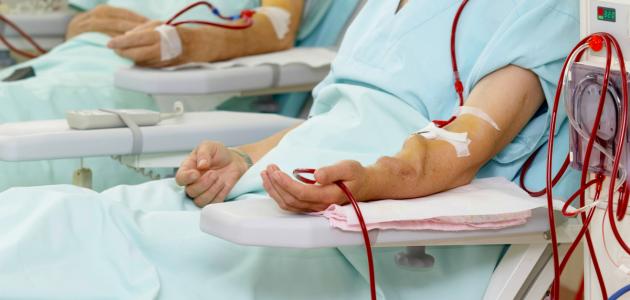General harms of dialysis
The harms or side effects that may accompany dialysis, hemodialysis, hemodialysis, or blood filtering (in English: dialysis) depend on the type followed, as dialysis is divided into two main types, which are peritoneal dialysis or peritoneal dialysis. , and hemodialysis (in English: Haemodialysis), in addition to that some of the symptoms that may appear on the affected person are due to the failure to fully compensate for kidney functions through dialysis. It is good to mention that the symptoms associated with dialysis can be alleviated by following a diet suitable for health. The kidneys and the condition of the affected person, after consulting a doctor to determine the appropriate proportion of fluids, salt, and proteins in the patient’s diet, in addition to avoiding exposure to some elements that are harmful to the kidneys, such as smoking, drinking alcohol, and using some illicit medications, and the following is a statement of some of the general symptoms that May accompany dialysis:
Fatigue and exhaustion
Feeling tired and exhausted are common symptoms associated with both types of dialysis in people who depend on dialysis for long periods, and there are many different factors that may play a role in people undergoing dialysis suffering from fatigue and fatigue, such as:
- The stress and psychological anxiety that the affected person may suffer from.
- Failure to fully compensate for kidney functions with dialysis.
- The strict diet imposed on the affected person, in addition to the effect of the dialysis process on the body.
The fatigue and exhaustion associated with dialysis can be alleviated by exercising regularly. It is recommended to perform light and moderate aerobic exercise, such as swimming, walking, jogging, and cycling. In fact, a person may face difficulty in starting exercise as a result of feeling fatigued. However, this feeling gradually disappears with commitment to exercise, and it is also recommended to consult a doctor about the possibility of modifying the diet to help obtain more energy and nutrients that help overcome fatigue.
Read also:Reasons for urinating frequently
Psychological effects
As a result of the major changes that occur in a person’s life after starting dialysis and his loss of the ability to rely on himself in many different tasks and his need to help others, many people may be exposed to some psychological effects, such as psychological anxiety and depression, and it may also be difficult for the person to adapt to a lifestyle. His new life was imposed on him as a result of his health condition, and the impact of dialysis schedules on his social activities such as work, school, and recreational activities, in addition to the isolation of young children who undergo dialysis from their friends, and their need to undergo a strict diet to ensure that they obtain the nutrients necessary for their growth. For teenagers and adults, the problem of dialysis may add more psychological pressure to them, resulting from a number of disorders common at this age, such as determining their identity and interests. It is worth noting that for elderly people undergoing dialysis, their dependence on others may have a lesser impact on their psychology. However, their heavy dependence on their children may affect the style of living at home in proportion to their health condition and responsibilities towards them. The psychological effects of dialysis can be mitigated by sharing experiences with other people with kidney disease, who have been undergoing dialysis for a long time, and sharing thoughts and feelings. With family members and close people.
These steps may help alleviate the psychological stress of dialysis patients:
Read also:What are the symptoms of kidney failure?- Talk to dialysis unit specialists.
- Get as much information as possible about the disease.
- Participate in various daily activities and responsibilities.
- Doing exercise.
- Seek help from social workers in the dialysis unit.
- Maintaining previous goals and trying to implement them.
- Be patient and set realistic goals in adapting to all lifestyle changes.
restless leg syndrome
Many people undergoing dialysis develop restless leg syndrome (RLS for short). It is a muscular and nervous disorder accompanied by an unpleasant feeling of itching and tingling in the legs, which leads to constant movement of the legs. The chance of these symptoms appearing increases while the affected person is sitting and lying down, which may affect his ability to sleep as well. It should be noted that there are many different causes that It may lead to restless legs syndrome, such as: iron deficiency, neuropathy, kidney disease and uremia, so it is worth consulting a doctor if any of the symptoms of restless legs syndrome appear. To diagnose its main cause and determine the appropriate treatment.
Harmful effects of hemodialysis
Many people who resort to dialysis adapt to the hemodialysis process, but some cases may be accompanied by some side effects as well, and it is good to mention that there are many different treatments and preventive measures available that help alleviate the side effects that may accompany hemodialysis. The following is an explanation of some of these effects and ways to mitigate them:
Read also:Symptoms of kidney pelvis inflammation
Harmful effects of dialysis during the session
- headache: The incidence of headache resulting from dialysis ranges between 27% and 37%, according to the Journal of Head and Face Pain published in 2016, and the incidence of headache associated with dialysis is defined based on the International Headache Society (in English: The International Headache Society (IHS) is a headache without specific characteristics that develops during dialysis and disappears spontaneously within 72 hours of completing the dialysis session, and the patient may need to use pain relievers such as acetaminophen.
- Nausea and vomiting: Nausea and vomiting are among the most common complications and harms during a dialysis session. In fact, the incidence of nausea and vomiting, based on a study published in the Journal of Renal Injury Prevention in 2017, is 28.3% and 11.7%, respectively.
- Muscle spasm: In some cases, the dialysis process may be accompanied by muscle cramps, resulting from the rapid withdrawal of fluids from the body or the removal of a large percentage of fluids. To alleviate this problem, the doctor may adjust the proportion of fluids and sodium in the affected person’s diet, or he may It modifies some of the procedures followed during the dialysis process, and it is worth noting that, based on a study published in the International Journal of Therapeutic Massage (in English: international journal therapeutic massage bodywork) in 2016, approximately 25% to 50% of dialysis patients are affected by muscle spasms during a dialysis session. Kidney or beyond.
- Reduction of Blood pressure: Low blood pressure (in English: Hypotension) is the most common side effect associated with the hemodialysis process, especially in people with diabetes (in English: Diabetes), and is usually accompanied by nausea and dizziness, and because the decrease in the percentage of fluids in the body during the dialysis process is one of the reasons. For low blood pressure, adhering to the daily amount of fluids recommended by the doctor is one of the main factors that helps prevent low blood pressure during dialysis. If symptoms continue to appear, you should consult your doctor about the possibility of adjusting the percentage of fluids needed for hemodialysis. It is worth noting that, based on a study published in the American Journal of Nephrology in 2019, approximately 10.1% of dialysis patients suffer from low blood pressure during the dialysis process.
Other damages
- Anemia: Anemia is also a common health complication that accompanies the dialysis process through hemodialysis and is a result of kidney failure. Anemia is defined as a decrease in the number of red blood cells in the blood below the normal rate, due to a decrease in the ability of the kidneys. On the production of the hormone erythropoietin. It is one of the main hormones responsible for stimulating the production of red blood cells. The loss of many vitamins and iron during the dialysis process, poor absorption of iron, strict restrictions on the affected person’s diet, and the frequent need to conduct blood tests for the affected person are other factors that may It contributes to anemia in this case, and it is worth mentioning that N
- Blood clots: The risk of blood clots forming in the area of the port used for blood transfusion increases during the dialysis process, so it is recommended to evaluate the operation of this port periodically to ensure that clots do not form. In some cases, the doctor may also prescribe the drug heparin (in English: Heparin) to help prevent the formation of clots. Blood circulation, or prevention of lack of blood flow (in English: Ischemia) to the extremities.
- Dry and itchy skin: The chance of dry skin increases in dialysis patients. To alleviate this problem, it is recommended to use moisturizing creams regularly, avoid bathing with hot water, or use soap that is not suitable for the skin. Hemodialysis may also be accompanied by itching of the skin, which in turn may be caused by a high percentage of the element Phosphorus in the blood of dialysis patients; Due to the inefficiency of washing machines in removing phosphorus from the blood, this problem can be alleviated by using some medications that bind to phosphorus and help get rid of it, and following a diet that does not contain a high percentage of phosphorus.
- Fluid accumulation: Some people may suffer from the problem of hypervolemia. It is high blood volume resulting from the inability of the kidneys to get rid of the excess amount of fluids. If the dialysis machine is not calibrated appropriately, the body may not get rid of the accumulated fluids efficiently. To prevent this problem, it is recommended to adhere to consuming an appropriate amount of fluids. As for the symptoms What may accompany hypervolemia may include swelling of the face and extremities, high blood pressure, headache, abdominal bloating and cramping, and shortness of breath.
- Sleep disturbances: Difficulty sleeping disorders often appear in many dialysis patients, and there are many different causes for these disorders, such as: pain, restless legs syndrome, and sleep apnea, which may appear in some sufferers.
- Infection: As a result of the port that is always connected to dialysis patients, the risk of infection increases greatly in these people, as it is easy for bacteria and various microorganisms to reach the bloodstream, so care must be taken to avoid tampering with this port to avoid bleeding, which in turn leads to a higher risk of infection and anemia. And blood vessel aneurysm (in English: Vascular aneurysm), and care must be taken to wash hands well with soap and water before providing treatment to the affected person, and to keep the used bandage clean and dry, and note the symptoms that may indicate infection and inform the doctor about their appearance immediately, and it can be inferred that Infection occurs in this case by observing a number of symptoms, such as: accumulation of purulent fluid under the skin, warmth and swelling of the affected area, pain, fever, and chills. It is worth noting that the bacterial infection is treated by the doctor in this case by prescribing an antibiotic (in English). : Antibiotics) appropriate.
- Bleeding: After the end of the dialysis process, the specialist removes the needle and leaves the plastic port that enters the bloodstream, taking care to stop the bleeding completely before leaving the dialysis center. If bleeding is noticed again after leaving the center, you must be careful to gently press the bleeding area with a dry cloth. And return directly to the treatment center to provide appropriate procedures in this case.
- Electrolyte disturbance: The risk of disturbances in the levels of various electrolytes in the body increases as a result of hemodialysis, so care must be taken to conduct periodic tests and monitor the symptoms appearing on the affected person to prevent this disorder. These disorders may include hypocalcemia, hypocalcemia, and... Blood sodium (in English: Hyponatremia), and hypermagnesemia (in English: Hypermagnesemia), in addition to hypokalemia (in English: Hypokalemia), as potassium is one of the electrolytes that play an important role in many body functions, such as muscle contraction and nerve signals, Regulating the proportion of fluids in the body, and blood fluid disturbances can be prevented by following a specific diet, in addition to adhering to the treatment plan determined by the doctor.
- Amyloidosis: Amyloidosis is one of the disorders related to dialysis, especially if it continues for long periods of more than five years. This health problem is represented by the accumulation of some proteins present in the blood in the joints and tendons, which leads to a feeling of pain, stiffness, and fluid accumulation in the joints.
- Pericarditis: In some cases where the efficiency of hemodialysis decreases, the patient may develop pericarditis. It is an inflammation of the membrane surrounding the heart, which may affect the heart's ability to pump blood to different parts of the body.
- Hypertension: High fluid or salt intake may cause high blood pressure in dialysis patients, which in turn may cause heart problems and strokes.
- Dialysis-associated imbalance syndrome: (in English: The dialysis disequilibrium syndrome) and DDS for short; It is a group of neurological symptoms resulting from the rapid elimination of urea from the body, which leads to a decrease in osmotic pressure in the blood plasma compared to the pressure in the brain cells, and thus the transfer of fluids from the blood plasma to the brain tissue, and often These symptoms usually appear at the end of a dialysis session, and this condition is accompanied by a number of different symptoms, such as nausea, vomiting, confusion, and headache.
- Other symptoms: There are many other symptoms that may appear as a result of hemodialysis, including the following:
- Dry mouth.
- Body and joint pain.
- Decreased sexual desire and erectile dysfunction in men.
- Arrhythmia.
- Some technical complications related to the dialysis process, such as air entrapment in the blood transfusion tube.
Harmful effects of hemodialysis using peritoneal dialysis
There are a number of side effects and health complications that may accompany peritoneal dialysis, some of which can be mentioned as follows:
- peritonitis: Peritonitis is one of the common side effects that may accompany peritoneal dialysis, which is represented by bacterial infection of the abdominal serous membrane, or what is known as the peritoneum. This infection is usually transmitted as a result of failure to sterilize the equipment used in The peritoneal dialysis process goes well, and it is worth noting that this condition is accompanied by a number of distinct symptoms that begin with nausea and loss of appetite, then immediately followed by mild abdominal pain that develops into severe and continuous pain, in addition to chills, vomiting, fever, rapid heartbeat, and thirst. Stopping urination or urinating only small amounts. To prevent peritonitis, care must be taken to clean and sterilize the dialysis equipment well. In the event of infection, the infection is treated with intravenous antibiotics. In this case, antibiotics are usually injected directly into the peritoneum area.
- Hernia: Hernia can be defined as the protrusion of one of the internal parts or organs of the body through one of the muscle tissues surrounding it as a result of its weakness. The appearance of a mass or protrusion in the abdomen is one of the main symptoms of an abdominal hernia. This mass is characterized by not being accompanied by pain in some cases, or It was discovered by chance during another medical examination, and surgery is the only way through which a hernia can be treated. Some people may feel pain in the hernia area as a result of performing some activities, such as: coughing, carrying heavy weights, bending, and engaging in sexual intercourse, as the risk increases. Hernia occurs in people who undergo peritoneal dialysis due to high pressure on the abdominal muscles as a result of fluid accumulation in this area when performing peritoneal dialysis.
- constipation: The risk of constipation increases in dialysis patients, which in turn may hinder peritoneal dialysis as a result of excessive pressure in the abdominal area. In this case, the doctor prescribes some medications that help relieve constipation, such as sorbitol. In this case, it is not recommended to prescribe Laxatives containing phosphate or magnesium.
- Weight gain: The fluid used in the peritoneal dialysis process contains some sugary elements that can be absorbed into the body, which in turn leads to an increase in the percentage of calories consumed by the affected person and gaining more weight. This effect varies between individuals and may have a significant effect in some few cases. Which leads to gaining a large percentage of weight, and to reduce this, you must be careful to follow a suitable diet, limit fat intake, and exercise, while being careful to avoid following a harsh diet that may affect the percentage of some important nutrients for the body.
- Inadequate dialysis:The process of dialysis using protein dialysis may become ineffective over time, leading to it being replaced by hemodialysis.









